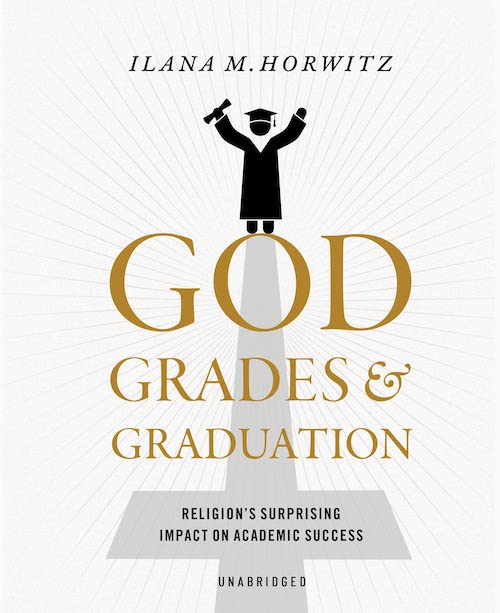Ilana M. Horwitz’s God, Grades, and Graduation is an important book for our time. It is important both for its primary argument about American education and for what it demonstrates about contemporary American political and religious divides. The thrust of the book is that religion makes a difference in the educational outcomes of adolescents, and thus impacts their entire professional and personal lives. Just as interesting, however, is the author’s perplexity at the life choices of the religious adolescents she studies. Horwitz finds it “astonishing” that one in four American teenagers has a deep relationship with God. The decisions these religious young people make seem to her to run counter to rationality and self-interest. The normal path, for Horwitz, is to parlay a successful high school career into admission to the most selective college possible. It also requires “critical thinking,” embracing new experiences, autonomy, self-direction, career success, and upward class mobility. In short, it is the set of values prized by secular progressive elite culture.
A new sociological study of the effect of traditional Christian faith on academic and professional achievement offers some surprises. It is no surprise, however, that a secular sociologist sees Christian teens as conformist and uncritical compared with their atheist peers. But whose values are the default in such a study?

By Ilana M. Horwitz
(Oxford University Press, 2022)
The religious adolescents she studies, however, confound these values. And they do so consistently, with enthusiasm, and in pursuit of a set of goods Horwitz finds decidedly unusual—like early marriage, early childbearing, and staying close to one’s family. She repeatedly stresses the passivity, docility, and obedience exhibited by religious teenagers, as well as their conformity to traditional gender roles.
For example: “Teenagers who live for God,” Horwitz writes, “may be well-behaved, but they don’t see themselves as steering the ship that is their life. Instead, they are more often than not passive actors in God’s play, waiting for their next direction.” She contrasts such attitudes with those of atheists, who are motivated by “the intrinsic desire to learn, not by the desire to be well-behaved.” Atheists are often marked by “confidence and intellectual ability” and are “self-driven, not God-centered.”
Horwitz is not completely unaware of her biases, and she explicitly denies any desire to “champion or denigrate” religion in general. I admire her candor in admitting that the subjects of her study are foreign to her personal experience. As she notes in the appendix, “My upbringing is quite different from the teenagers I highlight in this book and I was very concerned about how my personal experience would color my analysis.” She writes in the preface that because she grew up in communist Russia, she “didn’t even know what religion was until [she] was an early adolescent” and that she had “no interest in the lives of Conservative Christians until [she] was well into [her] thirties.”
Nevertheless, this lack of knowledge leads to a rather caricatured and limited understanding of the religious lives of adolescents she studies. She describes them in just the way conservative Christians appear in the pages of the New York Times: as obedient, passive, anxious about novelty, eager to obey authority, nervous about leaving home, and generally unwilling to think for themselves. In a telling sentence she claims that “people who are inclined toward being ‘risk-averse’ or ‘conformist’ may opt into religion because it aligns with their preference for structure and routine.”
Her knowledge of Christianity in general is also elementary. She informs us that “preachers in Southern Baptist churches tend to invoke themes of authority, loyalty, and sanctity compared to preachers in Unitarian churches,” and that “[a] central principle of Christianity is a commitment to authority.” A Baptist “is a kind of conservative Protestant,” she writes, and the hallmark of Evangelical churches is that “they affirm the orthodox teaching of the person of Christ as the sole rule of faith,” whatever that means exactly. Her claims about Christianity are either glaringly obvious or only about half right, which can make religious readers feel that they are being studied as if they were members of an aboriginal tribe in New Guinea.
I emphasize these shortcomings not to beat up on Horwitz but to make a broader point: This kind of scientific-sociological study may claim to be value-free but is in fact thoroughly value-laden. When one group (Christians) is described in a clearly critical set of terms—obedient, passive, authoritarian—and another (atheists and those with Jewish parents) as curious, autonomous, adventurous, and inquisitive, it is not hard to see where an author’s sympathies lie. Such sympathies are also indicative of America’s significant religious and cultural divide. One major axis of this divide is between orthodox religious believers, who usually skew conservative and live in flyover country, and secularists plus the “religious but not orthodox,” who skew progressive and live on the coasts. These groups often talk past each other because their concerns and ways of living are profoundly divergent.
Let me turn from criticism, however, to highlight the intriguing survey findings that Horwitz also brings to light. She builds on a significant body of sociological studies that demonstrate the radically different college attendance and economic success rates of those from low-income households versus those from professional-class homes. This much is widely accepted in the literature.
Horwitz wonders whether religion could have an independent effect on educational success rates—and indeed she finds that it does. Her data comes from the NSYR, the National Study of Youth and Religion. She designates a particular class of adolescents as “abiders”—those who believe in God, have been brought up in religious households, and who continue to hold their religious beliefs strongly throughout adolescence. Abider teens “espouse conservative Christian commitments, emphasizing the role of faith in their daily lives and their felt closeness to God, and attend religious services and pray on a regular basis.” Importantly, they orient their lives around a desire to please God, which means that they are generally obedient to the commands of religious authorities and their parents. They avoid drugs, alcohol, and sex, and they avoid peers who engage in these things. They are respectful to teachers, coaches, and adults in general. It is unsurprising, then, that they are well liked in school and that they often thrive.
Horwitz finds that these religious abiders fare quite differently depending upon their social class and income levels, however. Having divided the adolescent population into quartiles—poor, working class, middle class, and professional class—she finds that religion has by far the most impact on those in the middle 50% of the population (i.e., working and middle-class students, or the 25th through 75th percentiles of income).
The educational attainment (measured as the probability of earning a bachelor’s degree) of working-class abiders is double that of working-class nonabiders (32% versus 16%) and also significantly higher in middle class abiders (47% versus 29%). But the positive effect of religion on educational attainment is quite small among the poor (19% versus 15% for nonabiders). Most interesting of all, the advantage of religion for those in the top quartile of income is almost nonexistent. A full 62% of the nonreligious professional class is likely to earn a B.A., and abiders are only 3% more likely to earn one (65%).
In the most general sense, then, religion offers at least a slight advantage in educational attainment, whatever one’s income level. But why is the impact of religion so different across income levels? If religious observance is significantly advantageous to the middle 50%, why does this advantage seem to go away among the very highest earners?

Horwitz speculates that the answer has to do with increased social capital among working and middle-class abiders, which accrues to them through religion itself. Those in the professional class already have high levels of social capital. Their parents are likely to work in well-paying jobs, to be involved in civic and political life, and to have had college and graduate-level education. Their lives are often more or less “in order” so that, when a crisis hits, they know whom to call. If someone from the professional classes needs a lawyer, a medical specialist, or a CPA, he likely already knows someone who can help, and it may be a friend or colleague. Children from these classes also know lots of adults who appear in their lives as coaches, teachers, family friends, and parents of friends. They have abundant resources.
This is not always the case for the working and middle classes, and certainly not for the poor. But religion steps in to offer a ready-made source of social capital. At church, otherwise modestly situated young people are introduced to all sorts of people of different ages, in different roles. An adolescent might know her senior or youth pastor, the church secretary, and a host of other adults who attend church with her. She may volunteer through her church and meet yet another group of adults in the community. She will have friends at different schools through youth groups, whose parents are likely to be involved in their lives. She will, in short, have developed a network of contacts and also a network of accountability. All this pays benefits in keeping her grounded and within “God’s guardrails,” as Horwitz puts it. Unsurprisingly, then, such adolescents are much less likely to get in trouble with the law or have children before marriage, and thus to succeed in high school and subsequently attend and graduate from college.
It is, however, the top 25% who are the most intriguing part of this study. Here is where things take an unexpected turn—at least unexpected for Horwitz. She finds that the professional-class abiders often do not take the expected next step of applying to and attending the most prestigious and selective college they can. In fact, they often “undermatch”—i.e., they attend a school that is less selective than others that they are capable of getting into. Susanna, a typical young woman interviewed in the study, “does not see college as a stepping-stone to a successful career . . . instead of pursuing new experiences or stepping out of her comfort zone during her college years . . . Susanna sticks to the tried and true.” And her “primary ambitions remain the same after college as they were in high school: to start a family, help others, and orientate (sic) her life around God.”
Horwitz does not directly criticize these aspirations, but she immediately turns to a contrasting group—Jewish adolescent girls—who possess much more admirable characteristics. Unlike the abider girls, the Jewish girls are “open to new experiences” and the prospect of college is “exciting” rather than “fraught with anxiety” as it was for the abiders. In the words of one young Jewish 14-year-old, “I like people who are interested in learning and observing—not people who stay afraid on the surface and hang out there.”
Just as interesting to Horwitz is another group of high-achievers: atheists. Atheists, unlike the compliant abiders, are “intrinsically motivated to pursue knowledge” and are “autonomously motivated individuals who think critically and are driven by curiosity.” Abiders do well, by contrast, primarily because they are following a “hidden curriculum” that emphasizes “conformity” and “compliance” over actual merit. Our schools, Horowitz maintains, are shaped by “White Protestant culture,” and thus prepare students for “docile compliance with authoritarian work and political structures.” Abiders appear to do well in this framework.
Horwitz highlights one young atheist, Janet, who comments that the Bible and other religious books express ideas that are “just plain ludicrous . . . I think that anyone who claims to live their life by the Bible either hasn’t read it or is not telling the truth.” Horwitz then observes that “Janet doesn’t just thirst for knowledge—she also adapts her perceptions and understandings of the world as she accumulates more of it. She’s constantly reflecting on what she has read or seen in her own life to see how it fits or alters her current worldview.” Again: Initiative, inquisitiveness, and intellectual bravery are attributed to atheists; abiders are cautious and content with the social order.
Especially in the top 25%, religion seems to work against the goods of social progress, especially for those who undermatch and fail to aspire to the highest levels of professional success. The sentiments of abiders, comments Horwitz in her conclusion, “are likely to be at odds with some readers’ views of social progress.” In a subsequent, telling sentence, she wonders how religion can be good “if it places limits on people’s autonomy and endorses traditional gender roles?” I think what might be required is to question the very concepts of autonomy and gender roles—by considering the shocking possibility that autonomy might not be our highest good, and that traditional gender roles might carry some wisdom from the past.
Ultimately I want to offer both praise and criticism for this book. God, Grades, and Graduation is clearly written, easy to follow, and interesting to read—none of which are “givens” in modern social science writing. Horwitz has taken religion seriously and asks compelling questions about it.
But I think she fails to appreciate the actual variety and complexity of choices that face young people in the contemporary world. While many of them do embrace career, affluence, late childbearing, and uprooting themselves for a career, others—alternatively countercultural or benighted—pursue a different vision, one that comes to them at least in part through their faith.
Perhaps these young Christians imagine that family, place, and orientation toward God are more important in the final analysis than career and ambition. Thus they choose to stay put, to pursue less prestigious colleges and jobs, to have multiple children, and to stay near their parents. Such choices are not necessarily passive or fearful—indeed, it may take far more self-assurance to pursue such a course than to do what the world expects.
And though the survey data may imply that such people are less “curious,” it may also be that they are curious about quite different things: about what it means to be saved, what the Christian moral life requires, and how to bring one’s will in line with the will of God. These are not minor matters. Certainly I have known many young Christians who enthusiastically employ their well-developed “critical thinking skills” against precisely the kinds of goods and progressive political views that secular culture tells them they must pursue. Horwitz has not yet fully appreciated that religion is not just another demographic characteristic, but that it can entail a complete and radical revaluation of values, and a liberating expansion of the moral imagination.








